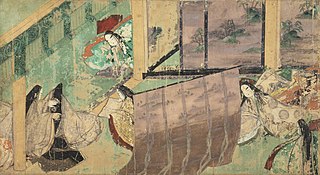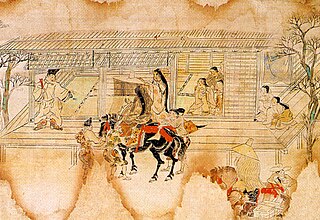Related Research Articles
Events from the year 1904 in art.
Events from the year 1955 in art.
Events from the year 1946 in art.
Events from the year 1928 in art.
Events from the year 1981 in art.
Events from the year 1917 in art.
Events from the year 1923 in art.
Events from the year 1929 in art.
Events from the year 1970 in art
Events from the year 1930 in art.
Events from the year 1953 in art.
Events from the year 1936 in art.
Events from the year 1935 in art.
Events from the year 1901 in art.
Events from the year 1927 in art.
Events from the year 1934 in art.
Events from the year 1945 in art.

Illustrated handscrolls, emakimono, or emaki (絵巻) is an illustrated horizontal narration system of painted handscrolls that dates back to Nara-period Japan. Initially copying their much older Chinese counterparts in style, during the succeeding Heian (794–1185) and Kamakura periods (1185–1333), Japanese emakimono developed their own distinct style. The term therefore refers only to Japanese painted narrative scrolls.

The Kibi Daijin Nittō Emaki is an emakimono or emaki from the end of the 12th century, in either the Heian or Kamakura periods of Japanese history. An illuminated manuscript, it was originally made up of a long paper scroll decorated with paint and calligraphy, and is now separated into four parts, all of which are held by the Museum of Fine Arts, Boston. It recounts the legend associated with the voyage of the Japanese Minister Kibi no Makibi to Imperial China of the Tang dynasty in the 8th century.

The Kokawa-dera Engi Emaki, is an emakimono or emaki from the 12th century, in either the Heian or Kamakura periods of Japanese history. An illuminated manuscript composed of a single scroll of paper, it illustrates the foundation of, and the miracles associated with, the Kokawa-dera Buddhist temple in the former Kii Province. The long paintings in the work were executed in a simple, uncluttered, Yamato-e style typical of Japanese paintings of the time.
References
- ↑ FitzGerald, Michael C. (1995). The Making of Modernism: Picasso and the Creation of the Market for Twentieth-Century Art.
- ↑ Decker, Karl (1932-06-25). "Why and How the Mona Lisa Was Stolen". The Saturday Evening Post.
- ↑ Maclean, Caroline (2020). Circles and Squares. London: Bloomsbury Publishing. ISBN 978-1-4088-8969-5.
- ↑ Cahill, Holger (1932). American Folk Art: The Art of the Common Man in America 1750–1900. New York: MoMA.
- ↑ Umezu, Jirō (1977). 粉和寺緣起絵 吉備大臣入唐絵[Kibi Daijin Nittō Emaki]. Shinshū Nihon emakimono zenshū. Vol. 6. Kadokawa Shoten.
- ↑ "Stuart Davis. Mural (Radio City Men's Lounge Mural: Men without Women). 1932 | MoMA".
- ↑ "Early Years » Biography » Gerhard Richter". www.gerhard-richter.com. Retrieved 25 August 2019.
- ↑ Eric Pace (2 September 2000). "Euan Uglow, 68, British Realist Who Won Praise for His Still Lifes" . The New York Times . p. A 17. Retrieved 5 December 2020.
- ↑ "Norval Morrisseau". The Canadian Encyclopedia. Retrieved 25 August 2024.
- ↑ Roberta Smith (30 May 1997). "James Lee Byars, 65, Creator Of Art That Lived in a Moment". The New York Times .
- ↑ McNay, Michael (9 March 2017). "Sir Howard Hodgkin obituary". The Guardian. Retrieved 23 January 2020.
- ↑ Stephen Bayley (12 September 2020). "Terence Conran Obituary". The Guardian. Retrieved 25 August 2024.
- 1 2 The Year's Art. J.S. Virture & Company. 1933. p. 270.
- ↑ Edward Pollack; Deborah C. Pollack (2023). Hermann Herzog: His Remarkable Life, Unrivaled Florida Work, and Rightful Place in American Art History. Blue Heron Press. pp. 27, 29–30.
- ↑ David Boyd Haycock (2009). A Crisis of Brilliance: Five Young British Artists and the Great War. Old Street Publishing (London). p. 2. ISBN 978-1-905847-84-6.
- ↑ Gaze, Delia (2011). Concise Dictionary of Women Artists. New York: Routledge. p. 167. ISBN 978-1-57958-335-4.
- ↑ Alfred H. Maurer, 1868-1932. United States National Collection of Fine Arts. 1973. p. 134.
- ↑ "Miss Gertrude Jekyll". The Times. No. 46313. London. 10 December 1932. p. 12.